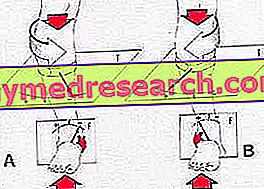Related articles: Knee launch
Definition
The varus knee is a deformity of the lower limb that occurs when the femur and the tibia form an obtuse angle open medially. The longitudinal axis of the leg deviates, therefore, towards the outside.
In common parlance, this condition is defined in several ways, including "knee knees", "bow knees" or "knees in parentheses".
The varus knee is physiological in a certain period of development; in particular, it is frequent in children who take their first steps (ie when the action of body weight begins to intervene) and, in general, they correct themselves spontaneously within 18 months. If it persists or worsens, varus may be a sign of Blount's disease (varus tibia); furthermore, rickets (caused by a lack of vitamin D) and other metabolic bone diseases must be excluded. Other causes include lead or fluoride intoxication, neurological disorders, arthrosis, ligament injuries and poorly consolidated fractures.
The knee is often found in professional footballers.

Most common symptoms and signs *
- Knee pain
- Articolar pains
- Muscle pains
- Legs tired, heavy legs
- Joint swelling
- Joint stiffness
Further indications
The most common symptoms of the varus knee are easily recognizable: the legs are arched on both sides of the body and the knees do not touch, bringing the tibial ankles into contact. In any case, a complete radiographic picture is needed to measure the extent of the deformation.
If varus is relevant, it can lead to an overload of the medial knee compartment, which is found to support most of the body weight during walking. This can cause pain and swelling of the affected part, as well as predispose to the appearance of bone or joint disorders, such as a degenerative meniscopathy.
Early use of braces can be effective, but surgical treatment is often necessary, to be chosen based on the patient's age and the severity of the deformity:
- In the age of growth, varism can be corrected with hemi-apifysiodesis (fixation of the external side of the knee) with cambres and stirrups (metallic supports able to keep the new ligaments together). This intervention stops bone growth selectively on the medial epiphyseal side, in such a way as to allow a progressive self-correction of the defect with development.
- A stabilized deformity, on the other hand, can be corrected with a valgating osteotomy that aims to realign the limb and restore proper joint biomechanics.



